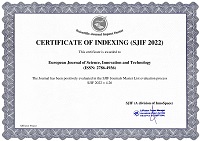Machine Learning-Enhanced Turbulence Prediction and Flow Optimization for Advanced Aerodynamic Design in High-Speed Regimes
Abstract
The design of high-speed aerodynamic systems is challenged by the need for accurate turbulence prediction and efficient flow optimization. Traditional Computational Fluid Dynamics (CFD) methods often fall short due to their computational intensity and limitations in resolving high-frequency turbulent structures. Recent advancements in Machine Learning (ML) have demonstrated significant potential in revolutionizing this field. By leveraging deep learning, reinforcement learning, and other advanced algorithms, ML models address the inherent complexities of turbulence with enhanced accuracy and computational efficiency.
This study explores the integration of ML techniques in turbulence prediction and flow optimization for high-speed aerodynamic applications. It identifies key challenges in traditional CFD methods, such as their reliance on Reynolds-averaged Navier-Stokes equations and large eddy simulations, which struggle with multi-scale turbulence phenomena. ML-based approaches, including Convolutional Neural Networks (CNNs) and Generative Adversarial Networks (GANs), offer innovative solutions for subgrid-scale modeling, flow field reconstruction, and real-time monitoring.
Additionally, the research highlights ML's role in aerodynamic optimization, employing reinforcement learning and genetic algorithms to automate design processes and achieve multi-objective optimization. Case studies demonstrate a 20% improvement in prediction accuracy for supersonic flows and substantial computational time savings. These findings underscore the transformative potential of ML in high-speed aerodynamic engineering, paving the way for next-generation aerospace technologies.
References
Bhatti, I., Rafi, H., & Rasool, S. (2024). Use of ICT Technologies for the Assistance of Disabled Migrants in USA. Revista Espanola de Documentacion Cientifica, 18(01), 66-99.
Bhatti, I., Waqar, M., & Khan, A. H. (2024). The Role of AI-Driven Automation in Smart Cities: Enhancing Urban Living through Intelligent System. Multidisciplinary Journal of Instruction (MDJI), 7(1), 101-114.
Chowdhury, A. A. A., Sultana, A., Rafi, A. H., & Tariq, M. (2024). AI-Driven Predictive Analytics in Orthopedic Surgery Outcomes. Revista Espanola de Documentacion Cientifica, 19(2), 104-124.
Farhan, M., Rafi, H., & Rafiq, H. (2015). Dapoxetine treatment leads to attenuation of chronic unpredictable stress induced behavioral deficits in rats model of depression. Journal of Pharmacy and Nutrition Sciences, 5(4), 222-228.
Farhan, M., Rafi, H., & Rafiq, H. (2018). Behavioral evidence of neuropsychopharmacological effect of imipramine in animal model of unpredictable stress induced depression. International Journal of Biology and Biotechnology, 15(22), 213-221.
Farhan, M., Rafi, H., Rafiq, H., Siddiqui, F., Khan, R., & Anis, J. (2019). Study of mental illness in rat model of sodium azide induced oxidative stress. Journal of Pharmacy and Nutrition Sciences, 9(4), 213-221.
Farhan, M., Rafiq, H., & Rafi, H. (2015). Prevalence of depression in animal model of high fat diet induced obesity. Journal of Pharmacy and Nutrition Sciences, 5(3), 208-215.
Farhan, M., Rafiq, H., Rafi, H., Ali, R., & Jahan, S. (2019). Neuroprotective role of quercetin against neurotoxicity induced by lead acetate in male rats. Int. J. Biol. Biotech., 16 (2): 291-29.
Farhan, M., Rafiq, H., Rafi, H., Rehman, S., & Arshad, M. (2022). Quercetin impact against psychological disturbances induced by fat rich diet. Pakistan Journal of Pharmaceutical Sciences, 35(5).
Ghulam, T., Rafi, H., Khan, A., Gul, K., & Yusuf, M. Z. (2021). Impact of SARS-CoV-2 Treatment on Development of Sensorineural Hearing Loss: Impact of SARS-CoV-2 treatment on SNHL. Proceedings of the Pakistan Academy of Sciences: B. Life and Environmental Sciences, 58(S), 45-54.
Gill, A. Y., Saeed, A., Rasool, S., Husnain, A., & Hussain, H. K. (2023). Revolutionizing Healthcare: How Machine Learning is Transforming Patient Diagnoses-a Comprehensive Review of AI's Impact on Medical Diagnosis. Journal of World Science, 2(10), 1638-1652.
Husnain, A., Rasool, S., Saeed, A., Gill, A. Y., & Hussain, H. K. (2023). AI'S healing touch: examining machine learning's transformative effects on healthcare. Journal of World Science, 2(10), 1681-1695.
Hussain, I., & Nazir, M. B. (2024). Empowering Healthcare: AI, ML, and Deep Learning Innovations for Brain and Heart Health. International Journal of Advanced Engineering Technologies and Innovations, 1(4), 167-188.
Hussain, I., & Nazir, M. B. (2024). Mind Matters: Exploring AI, Machine Learning, and Deep Learning in Neurological Health. International Journal of Advanced Engineering Technologies and Innovations, 1(4), 209-230.
Hussain, I., & Nazir, M. B. (2024). Precision medicine: AI and machine learning advancements in neurological and cardiac health. Revista Espanola de Documentacion Cientifica, 18(02), 150-179.
Khan, A. H., Zainab, H., Khan, R., & Hussain, H. K. (2024). Deep Learning in the Diagnosis and Management of Arrhythmias. Journal of Social Research, 4(1).
Khan, A. H., Zainab, H., Khan, R., & Hussain, H. K. (2024). Implications of AI on Cardiovascular Patients’ Routine Monitoring and Telemedicine. BULLET: Jurnal Multidisiplin Ilmu, 3(5), 621-637.
Khan, R., Zainab, H., Khan, A. H., & Hussain, H. K. (2024). Advances in Predictive Modeling: The Role of Artificial Intelligence in Monitoring Blood Lactate Levels Post-Cardiac Surgery. International Journal of Multidisciplinary Sciences and Arts, 3(4), 140-151.
Lodhi, S. K., Gill, A. Y., & Hussain, I. (2024). 3D Printing Techniques: Transforming Manufacturing with Precision and Sustainability. International Journal of Multidisciplinary Sciences and Arts, 3(3), 129-138.
Lodhi, S. K., Hussain, H. K., & Gill, A. Y. (2024). Renewable Energy Technologies: Present Patterns and Upcoming Paths in Ecological Power Production. Global Journal of Universal Studies, 1(1), 108-131.
Nasir, S., Zainab, H., & Hussain, H. K. (2024). Artificial-Intelligence Aerodynamics for Efficient Energy Systems: The Focus on Wind Turbines. BULLET: Jurnal Multidisiplin Ilmu, 3(5), 648-659.
Nazir, M. B., & Hussain, I. (2024). Charting new frontiers: Ai, machine learning, and deep learning in brain and heart health. Revista Espanola de Documentacion Cientifica, 18(02), 209-237.
Nazir, M. B., & Hussain, I. (2024). Revolutionizing Cardiac Care: AI and Deep Learning in Heart Health. International Journal of Advanced Engineering Technologies and Innovations, 1(4), 189-208.
Rafi, A. H., Chowdhury, A. A. A., Sultana, A., & Noman, A. A. (2024). Enhancing Green Economy with Artificial Intelligence: Role of Energy Use and FDI in the United States. Journal of Environmental and Energy Economics, 55-76.
Rafi, A. H., Chowdhury, A. A. A., Sultana, A., & Noman, A. A. (2024). Unveiling the Role of Artificial Intelligence and Stock Market Growth in Achieving Carbon Neutrality in the United States: An ARDL Model Analysis. Journal of Environmental Science and Economics, 3(4), 130–155.
Rafi, A. H., Sultana, A., Chowdhury, A. A. A., & Tariq, M. (2024). Artificial Intelligence for Early Diagnosis and Personalized Treatment in Gynecology. International Journal of Advanced Engineering Technologies and Innovations, 2(1), 286-306.
Rafi, H. (2024). Peer Review of “Establishment of a Novel Fetal Ovine Heart Cell Line by Spontaneous Cell Fusion: Experimental Study”. JMIRx Bio, 2(1), e63336.
Rafi, H., & Farhan, M. (2015). Dapoxetine: An Innovative Approach in Therapeutic Management in Animal Model of Depression. Pakistan Journal of Pharmaceutical Sciences, 2(1), 15-22.
Rafi, H., Ahmad, F., Anis, J., Khan, R., Rafiq, H., & Farhan, M. (2020). Comparative effectiveness of agmatine and choline treatment in rats with cognitive impairment induced by AlCl3 and forced swim stress. Current Clinical Pharmacology, 15(3), 251-264.
Rafi, H., Rafiq, H., & Farhan, M. (2021). Antagonization of monoamine reuptake transporters by agmatine improves anxiolytic and locomotive behaviors commensurate with fluoxetine and methylphenidate. Beni-Suef University Journal of Basic and Applied Sciences, 10, 1-14.
Rafi, H., Rafiq, H., & Farhan, M. (2021). Inhibition of NMDA receptors by agmatine is followed by GABA/glutamate balance in benzodiazepine withdrawal syndrome. Beni-Suef University Journal of Basic and Applied Sciences, 10, 1-13.
Rafi, H., Rafiq, H., & Farhan, M. (2023). Agmatine alleviates brain oxidative stress induced by sodium azide.
Rafi, H., Rafiq, H., & Farhan, M. (2024). Pharmacological profile of agmatine: An in-depth overview. Neuropeptides, 102429.
Rafi, H., Rafiq, H., Hanif, I., Rizwan, R., & Farhan, M. (2018). Chronic agmatine treatment modulates behavioral deficits induced by chronic unpredictable stress in wistar rats. Journal of Pharmaceutical and Biological Sciences, 6(3), 80.
Rafi, H., Rafiq, H., Khan, R., Ahmad, F., Anis, J., & Farhan, M. (2019). Neuroethological study of ALCL3 and chronic forced swim stress induced memory and cognitive deficits in albino rats. The Journal of Neurobehavioral Sciences, 6(2), 149-158.
Rafiq, H., Farhan, M., Rafi, H., Rehman, S., Arshad, M., & Shakeel, S. (2022). Inhibition of drug induced Parkinsonism by chronic supplementation of quercetin in haloperidol-treated wistars. Pak J Pharm Sci, 35, 1655-1662.
Rasool, S., Ali, M., Hussain, H. K., & Gill, A. Y. (2023). Unlocking the Potential of Healthcare: AI-Driven Development and Delivery of Vaccines. International Journal of Social, Humanities and Life Sciences, 1(1), 29-37.
Rasool, S., Ali, M., Shahroz, H. M., Hussain, H. K., & Gill, A. Y. (2024). Innovations in AI-Powered Healthcare: Transforming Cancer Treatment with Innovative Methods. BULLET: Jurnal Multidisiplin Ilmu, 3(1), 118-128.
Rasool, S., Husnain, A., Saeed, A., Gill, A. Y., & Hussain, H. K. (2023). Harnessing predictive power: exploring the crucial role of machine learning in early disease detection. JURIHUM: Jurnal Inovasi dan Humaniora, 1(2), 302-315.
Saeed, A., Husnain, A., Rasool, S., Gill, A. Y., & Amelia, A. (2023). Healthcare Revolution: How AI and Machine Learning Are Changing Medicine. Journal Research of Social Science, Economics, and Management, 3(3), 824-840.
Sultana, A., Rafi, A. H., Chowdhury, A. A. A., & Tariq, M. (2023). Leveraging Artificial Intelligence in Neuroimaging for Enhanced Brain Health Diagnosis. Revista de Inteligencia Artificial en Medicina, 14(1), 1217-1235.
Sultana, A., Rafi, A. H., Chowdhury, A. A. A., & Tariq, M. (2023). AI in Neurology: Predictive Models for Early Detection of Cognitive Decline. Revista Espanola de Documentacion Cientifica, 17(2), 335-349.
Waqar, M., Bhatti, I., & Khan, A. H. (2024). AI-Powered Automation: Revolutionizing Industrial Processes and Enhancing Operational Efficiency. Revista de Inteligencia Artificial en Medicina, 15(1), 1151-1175.
Waqar, M., Bhatti, I., & Khan, A. H. (2024). Leveraging Machine Learning Algorithms for Autonomous Robotics in Real-Time Operations. International Journal of Advanced Engineering Technologies and Innovations, 4(1), 1-24.
Waqar, M., Khan, A. H., & Bhatti, I. (2024). Artificial Intelligence in Automated Healthcare Diagnostics: Transforming Patient Care. Revista Espanola de Documentacion Cientifica, 19(2), 83-103.
Zainab, H., Khan, A. H., Khan, R., & Hussain, H. K. (2024). Integration of AI and Wearable Devices for Continuous Cardiac Health Monitoring. International Journal of Multidisciplinary Sciences and Arts, 3(4), 123-139.
Zuberi, S., Rafi, H., Hussain, A., & Hashmi, S. (2023). Role of Nrf2 in myocardial infarction and ischemia-reperfusion injury. Physiology, 38(S1), 5734743.
Copyright (c) 2024 Farrukh Sher Malik, Shumail Sahibzada, Sheharyar Nasir, Shahrukh Khan Lodhi

This work is licensed under a Creative Commons Attribution 4.0 International License.


 ISSN
ISSN 











